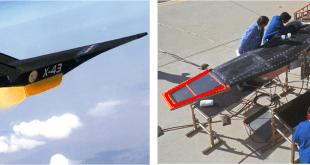The composites industry is constantly being shaped and reshaped by myriad forces – people, markets, technologies – all stimulating innovative new ways to apply fiber-reinforced materials in everything from boats and wind blades to airplanes and automobiles
Thermoplastics are synthetic plastics that can be melted, shaped, and cooled to form specific design shapes. Thermoplastics can undergo repeated melting and cooling processes, whereas thermoset plastics only set once and burn when exposed to heat after setting.
Thermoplastics are plastic materials that become pliable or moldable when heated above a specific temperature and harden upon cooling. Thermoplastic welding is a process used for joining pieces of thermoplastic material using heating, pressure and cooling.
To begin the weld, the surface of the thermoplastic material is heated to its melting point, or thermoplastic state. Each material has its own thermoplastic state, which usually ranges between 250°C (480°F) and 500°C (1022°F). The material is then pressed together until it cools. The pressure applied allows molecules in the material to newly position themselves, or to bond with molecules of another part.
Several methods of welding have been developed for thermoplastics. Hot air plastic welding is generally used on thermoplastic materials with a thickness of 1/16 of an inch or more.
Benefits
Thermoplastic welding has several benefits for manufacturing industries: High-strength plastic welding, Design flexibility, Low processing costs, and Better fatigue properties than metals
Thermoplastic welding allows manufacturers to create complex, intricate joints in thermoplastic components with durable molecular bonds that are more reliable and effective than more traditional mechanical fasteners and adhesives. Welded components can be joined into a single product quickly and efficiently, creating a long-lived weld that is both strong and dependable
Commonly Welded Thermoplastic Materials
Many thermoplastics are available on the market, each with unique features that make it useful for particular products and applications. Some of the most popular thermoplastics include:
Polyethylene (PE)
A lightweight ethylene polymer resin, polyethylene has a variable crystalline structure that makes it highly versatile. It is inexpensive, chemical resistant, and available in high- and low-density formulations for use in everything from medical implements to plastic bags.
Polyethylene (PE) -Agriculture and geomembrane industries have been welding polyethylene for years, but the sign industry has started to adopt this type of welding as well.
Polypropylene (PP)
Multiple propylene monomers combine to create polypropylene, a rigid and inflexible semicrystalline thermoplastic that is ideal for packaging, medical implements, and low-friction components. Polypropylene (PP) -Industries such as ducting and packaging use polypropylene coated fabrics for a variety of applications.
Polyvinyl chloride (PVC)
Designers and manufacturers value PVC for its chemical resistance and toughness. This polymerized synthetic resin made from vinyl chloride sees frequent use in pipes and fixtures, construction supplies, medical devices, electronics, and automotive components.
Polyvinylchloride (PVC) -The awning, sign, banner, tent and ducting industries commonly use PVC laminated fabric.
Polystyrene (PS)
Polystyrene is a synthetic polymer composed of styrene monomers and available in foam and solid forms. Solid polystyrene is transparent and hard, often used in food and pharmaceutical packaging, medical equipment, and laboratory equipment.
Other thermoplastic materials and applications include: Weldable Webbing, Plastic Welding, PVC, Polypropylene, Bonding Tapes, Keder, Non-Woven Materials, Polypropylene, HDPE & LDPE
Aerospace applications
Thermoplastic composites welding has the potential to significantly improve the sustainability of commercial aircraft production. Tier 1 airframer Collins Aerospace (Charlotte, N.C., U.S.) claims on its website that more automated, out-of-autoclave (OOA), weldable thermoplastic structures have the potential to reduce manufacturing cycle time by up to 80% and weight by up to 50% compared to previous metal and thermoset composite assemblies.
These previous assemblies use drilling and mechanical fasteners, requiring up to nine manufacturing steps. “We believe that for a new, A320-type single-aisle aircraft in five to eight years, thermoplastic composites will be a game-changer, not only to enable higher production rates but also best cost and weight,” says Cedric Eloy, deputy chief CTO, Tier 1 airframer Daher Aerospace (Paris, France). “If we want to take advantage of thermoplastic composites, we need to weld for fastener-less assembly, or at least with minimal fasteners,” adds Dominique Bailly, Daher VP of R&D.
Collins Aerospace to build F-16 ventral fin using thermoplastic technology
The US Air Force Research Laboratory (AFRL) has awarded a contract to Collins Aerospace to develop a prototype of ventral fin for the F-16 fighter aircraft, reported in Oct 2022. As part of this three-year contract, the company will develop F-16 ventral flight structures using a specialised component design, prototype fabrication and welding process. The contract will see Collins leveraging its thermoplastic welding technology to build the advanced high-impact resistant fins.
This technology is expected to reduce the weight and cost of the existing F-16 aircraft structure’s design. Collins Aerospace Aerostructures vice-president and general manager Stan Kottke said: “We are seeing an increased demand and opportunity to replace legacy aircraft components with thermoplastics. “The trend is using advanced thermoplastic materials to lower the cost and weight while reducing our overall environmental footprint, and those benefits are directly passed on to our customer.”
 International Defense Security & Technology Your trusted Source for News, Research and Analysis
International Defense Security & Technology Your trusted Source for News, Research and Analysis

